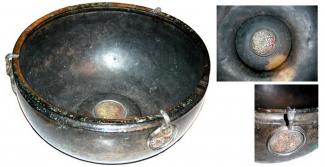The Winchester Hanging Bowl
Anglo-Saxon, late 7th or 8th century AD
Found in an Anglo-Saxon grave during excavations led by local archaeologist W J Andrew at Oliver's Battery, near Winchester, in 1930
Made of beaten bronze, with two spirally decorated enamelled and tinned roundels on the inside and the underside of the base, the bowl bears a further three roundels terminating in hooks shaped like aquatic birds on the rim. The best parallels for the spiral designs are to be found in the Book of Durrow, a late 7th century manuscript now housed at Trinity College, Dublin, suggesting that the bowl was acquired through trade, as a gift, or commissioned from a British or Irish metalworker.
The hanging bowl seems to have been designed to be filled with clear liquid, so that the internal basal roundel could still be seen when it was in use. The provision of suspension hooks suggests that it was stored hanging from the rafters, so that the roundel on the underside was visible. In a Christian context, one might envisage the clear liquid to be holy water, and such a bowl to form part of the 'church plate'. Ostentatious display of treasure and use at secular feasts in an Anglo-Saxon hall might also be imagined.



